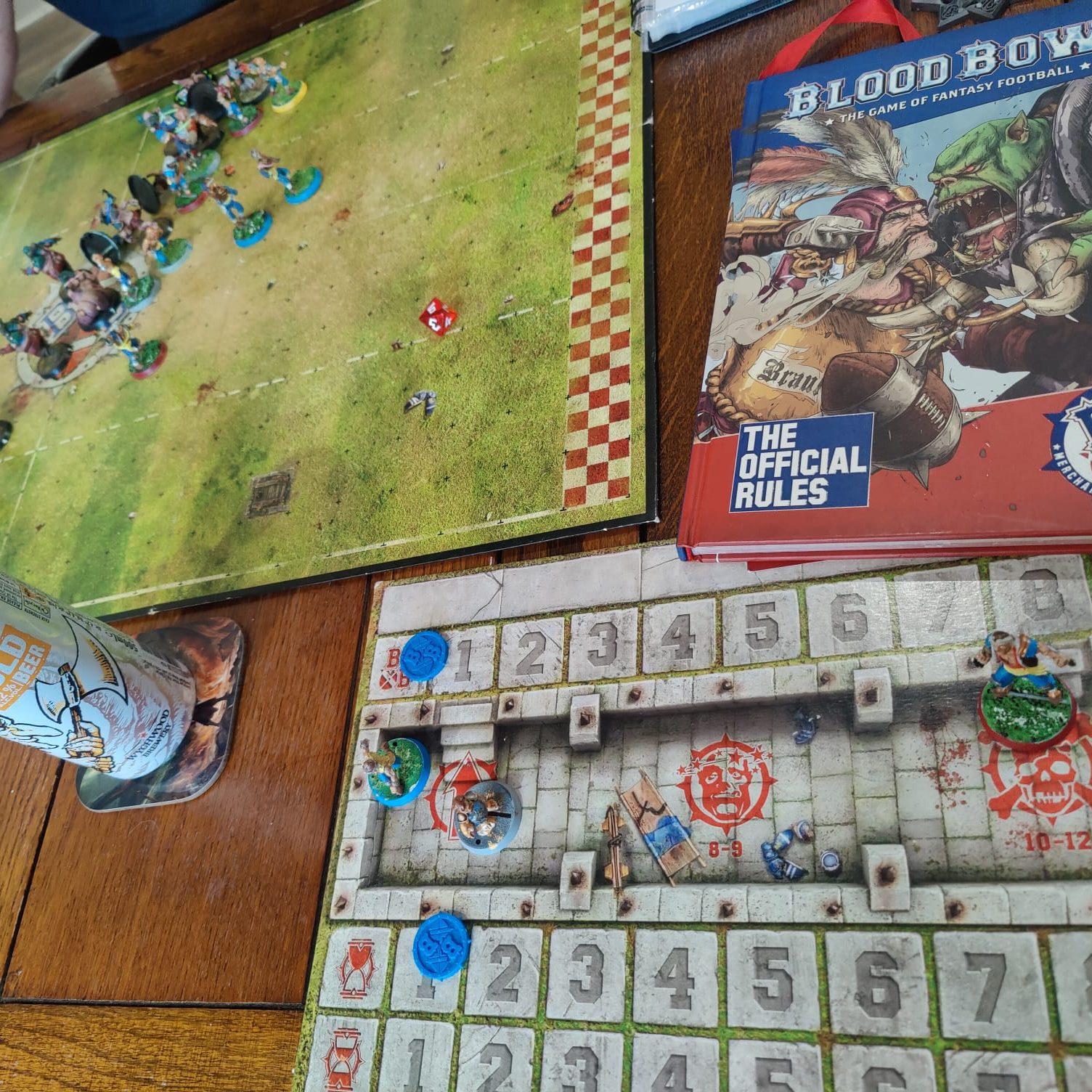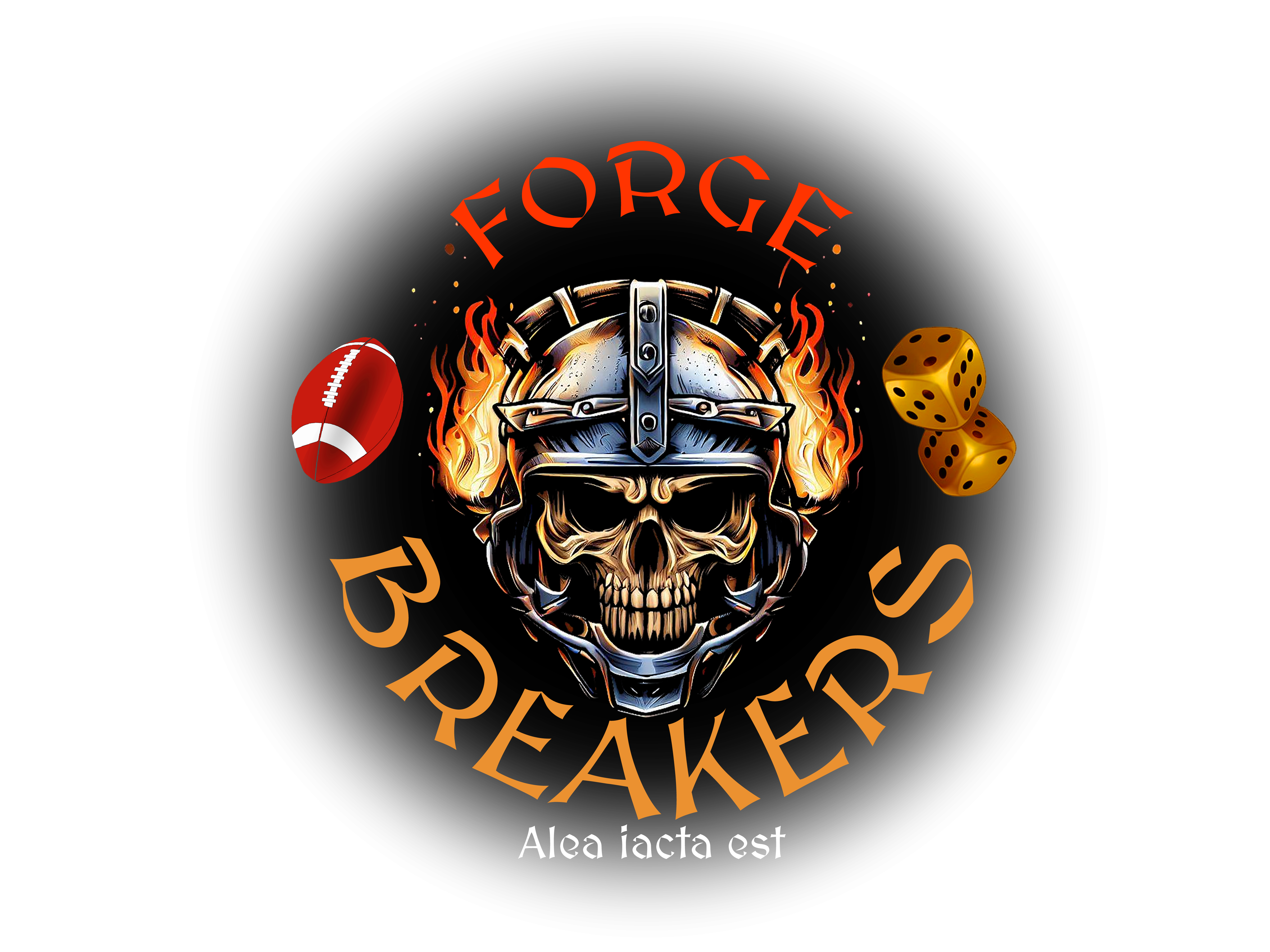Introduction
Lets start with some of the basics…
What is Blood Bowl?
Blood Bowl is a fantasy football board game by Games Workshop, where teams made up of Orcs, Elves, Humans, and other Warhammer fantasy races clash in a brutal, turn-based sport. It combines strategy, dice-based risk management, and over-the-top humour.
Blood Bowl Third Season edition (also known as BB2025) is the latest edition of the game.
Alongside the main version of the game, there are a few variants which lean into smaller scale matches, playing in Dungeons or on the grubby street of the local market… but in this guide we will focus entirely on the standard version of the game, played between teams of 11 players.
why play Blood bowl?
There’s many reasons why Blood Bowl is a fantastic game to get into.
It’s one of the best story-generating games around – each and every dice roll brings incredible tension, and whether you’re relaxing with a beer and regaling your friends about that time your Orc Blitzer dodged a few tackles to push through your opponent’s defence to carry the ball to the end zone and your team to victory, or that time your Skaven Gutter Runner pushed itself just a bit too far, tripped on the goal line, broke its neck, and died… you’ll quickly gather a slew of memories of last-turn heroics and heartbreaks.
Blood Bowl is currently experiencing its golden age. There’s multiple events held each weekend and, in Wiltshire, you only need to casually swing your Gnoblar around to find leagues and local groups a-plenty!
what do i need to play?
Blood Bowl is very accessible and has one of the lowest barriers to entry of any GW game. To play a match you’ll require:
Blood bowl history
Blood Bowl has been around a long time! Here’s some handy links if you want to take a trip down memory lane:
Recommended first steps
What do I need to buy first?
The Blood Bowl Season Three starter set from GW retails for around £80 and is a great way to source all the equipment you’ll need to play Blood Bowl – two teams, a pitch, a couple of balls, rulers and templates, and plenty of dice to assist you in fully experiencing the blessings of Nuffle at the most inopportune moments. That’s not to say its the only method. Pitches, templates, rule book and dice can all be sourced individually, either through GW, other retailers or cheaply on eBay.
There’s also an endless array of 3rd party teams, dice, gaming aids, cases & pitches available for coaches to purchase and use alongside, or instead of, GW ‘official’ products.
Key concepts *WIP*
Lorem ipsum dolor sit amet, at mei dolore tritani repudiandae. In his nemore temporibus consequuntur, vim ad prima vivendum consetetur.
TBC
TBC
Agility (AG), Passing Ability (PA) and Armour Value (AV) are all shown as target numbers; a number followed by a ‘+’ symbol. In the case of AG and PA a lower number is better, whereas in the case of AV a higher number is better.
TBC
TBC
TBC
Core mechanics *WIP*
Lets have a high level look at some of the core mechanics involved in a game of Blood Bowl.
On your turn, you may:
If you fail an action (e.g. drop the ball, fail a dodge, knock your own player down on a block), your turn ends immediately.
Each team member (model) comes with a standard set of stats.
Agility (AG), Passing Ability (PA) and Armour Value (AV) are all shown as target numbers; a number followed by a ‘+’ symbol. In the case of AG and PA a lower number is better, whereas in the case of AV a higher number is better.
Blood Bowl Dice
In Blood Bowl we use 4 different varieties of dice to determine the outcome of actions and events. D6, D8 and D16 are regular dice and used alongside ‘Block dice’ which are unique to Blood Bowl.
Block dice
Block dice are used to resolve Block and Blitz actions against opposition players. They are six-sided dice that feature five unique icons (one is duplicated on two faces), each representing a different outcome.
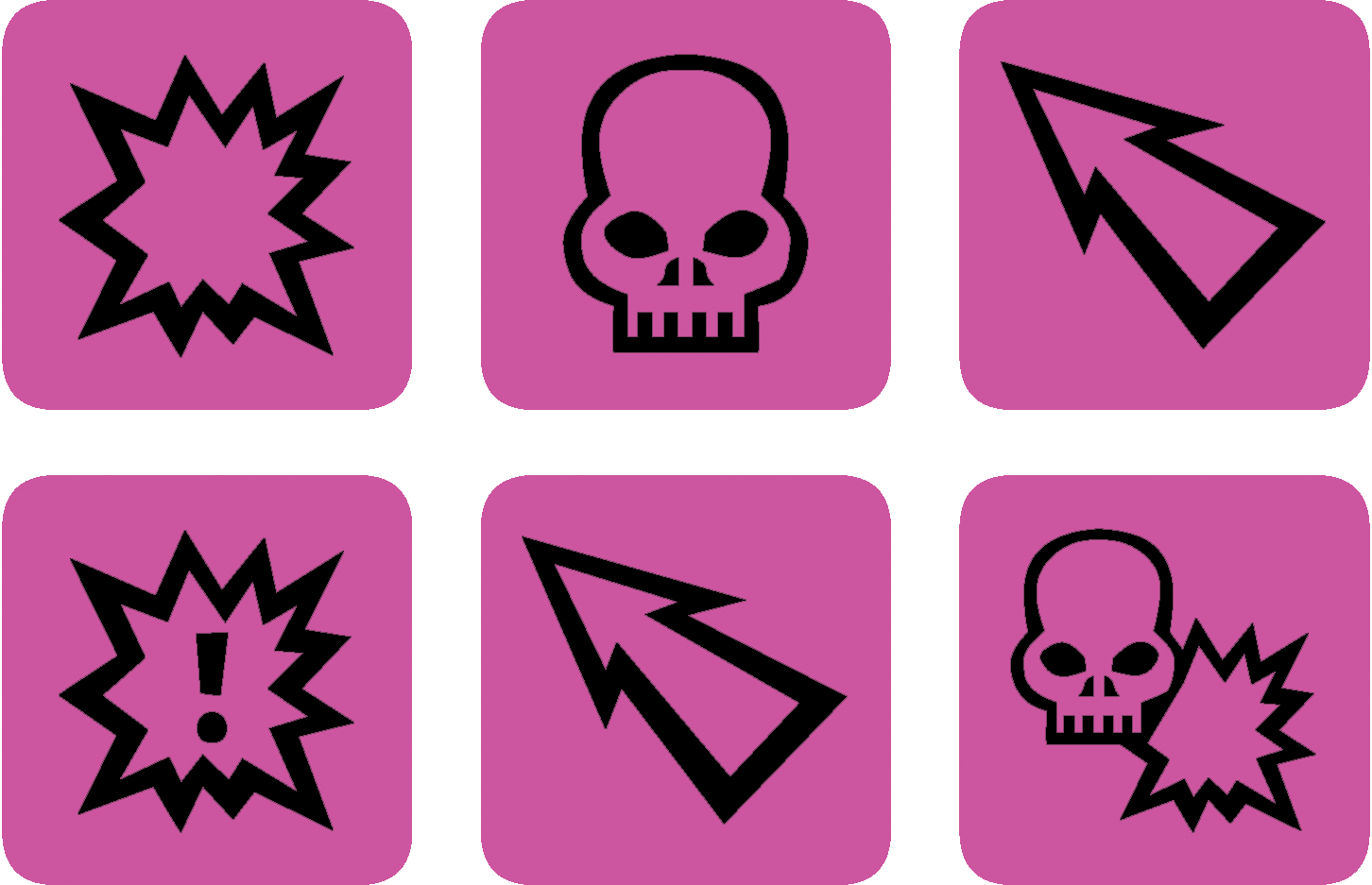
The D6 dice are for many of the standard actions (e.g. Dodging, Passing, picking up the ball). D8s and D16s are used when resolving ball scatter or results on various tables (i.e. the casualty table when a player has been injured).
The utilisation of dice adds the risk and reward element to Blood Bowl. A coach must understand their approach to this risk management; it’s important in the context of finding a team which provides that playstyle.
Understanding skills is critical to both getting the best out of your players, and to help understand where the biggest threat to your players will come from.
Alongside the stat line, all players have skills* (e.g. Block, Dodge, Sure Hands) that:
*many players start with various skills as standard, where as some players do not have any skills as part of their basic player details. Note adding skills to players is something you’ll experience through player progression in leagues or via tournament skill packs.
In Blood Bowl, “inducements” are special advantages that teams can buy before a match to level the playing field, usually when one team has a lower Team Value than their opponent. They’re temporary boosts – like hiring star players, wizards, or shady referees – that last only for that game.
What Inducements Represent
Common Types of Inducements
How They Work in Play
Why they matter
Inducements add flavour, unpredictability, and fairness to Blood Bowl. They ensure that underdogs aren’t steamrolled, while also injecting humour and chaos—whether it’s a drunken star player, a sneaky bribe, or a wizard hurling fireballs at the pitch.
Your first team
Here we cover basic details for each team in Blood Bowl. Notes on flavour and video guides (by Bonehead Podcast and Jimmy Fantastic) to help you pick a suitable first team.
Highly skilled and agile, Amazons are among the very best players of Nuffle’s sacred game. These warrior-athletes possess an exceptional blend of agility, tactical prowess, and violence that makes them thrilling to watch on the pitch, with an acrobatic style of play honed by years spent darting through dense rainforest and evading apex predators. With tactics moulded around the deadliest animals of their jungle home, these players unleash vicious hit-and-run moves that dazzle Blood Bowl fans and opponents alike.
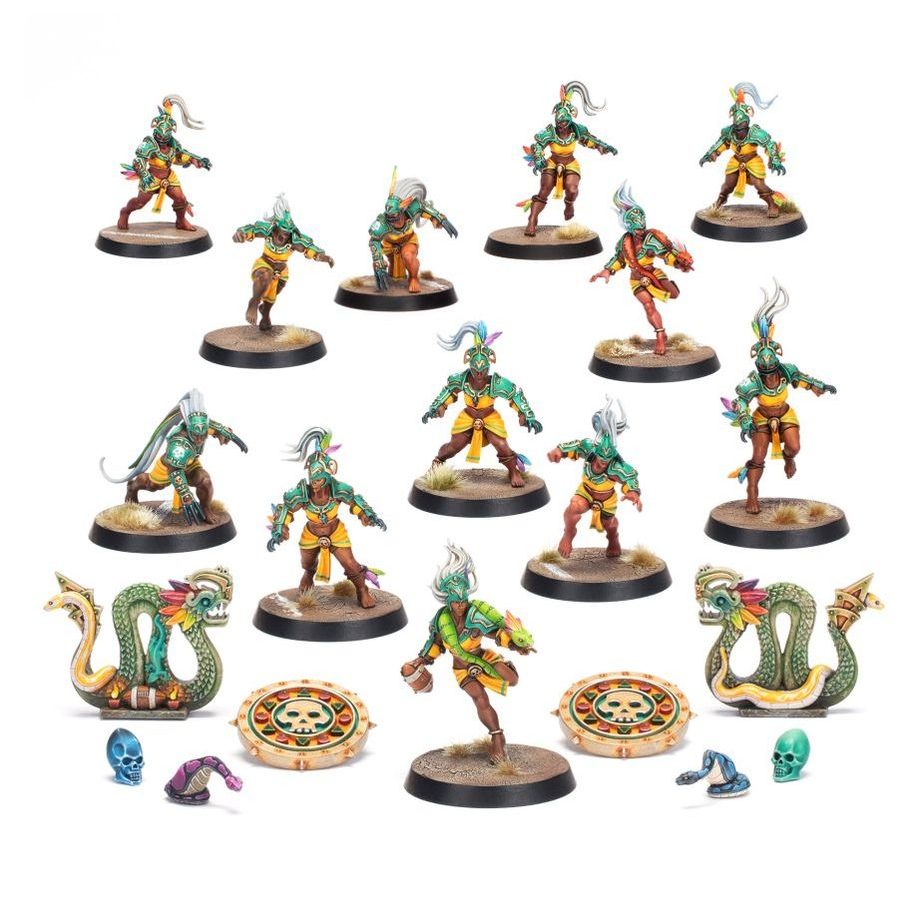
A mix of high strength/armour and low strength/armour players, the Black Orcs play a running (ok, more like jogging) game and certainly don’t chuck the ball around. They tend to plod down the field in a classic ‘cage’ formation, scoring late in their own drive hoping to contain the opposition in defence. If you like Italian football and grinding out a 1-0 win, then maybe these guys are for you!
That said, they do have access to some fun stuff. Bribes are cheap and allow you to keep cheap secret weapon star players on the pitch and also allow you to foul a bit more than other teams with less risk of being sent off.
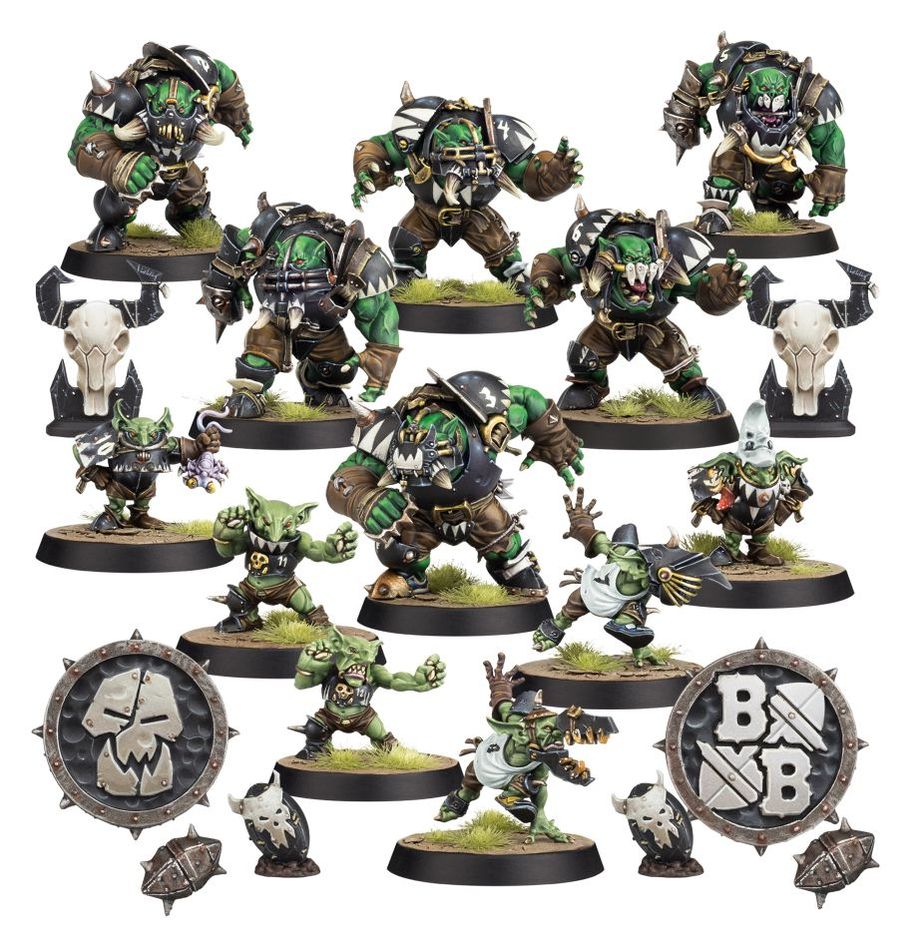
The Bretonnian Blood Bowl team plays with the flavour of chivalric bravado and reckless nobility. Imagine knights in gleaming armour charging headlong into scrums, their squires scrambling behind to patch gaps and fetch glory where they can. They thrive on honour, flair, and a touch of arrogance—every touchdown feels like a joust won, every fumble a stain upon their lineage. Their style is bold but brittle: dazzling blitzes and gallant leaps offset by fragile linemen and a reliance on fortune’s favour. They embody medieval pageantry on the pitch, equal parts pomp, pride, and peril, forever chasing legendary renown.
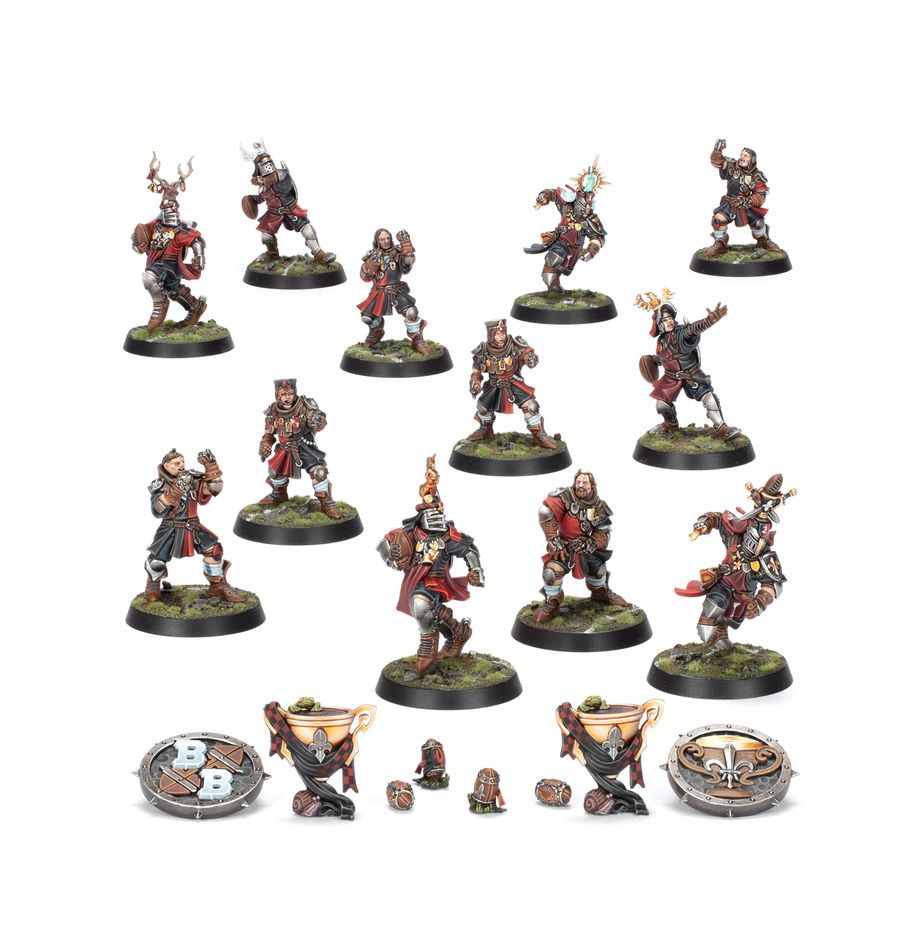
Chaos Chosen Blood Bowl teams are what happens when the deadliest of Chaos Warriors don’t have wars to fight, as is the case in the Blood Bowl setting. Strong and powerful, they’re here to crush their opponents into the dirt and demonstrate their absolute superiority over the lesser races (everyone else).
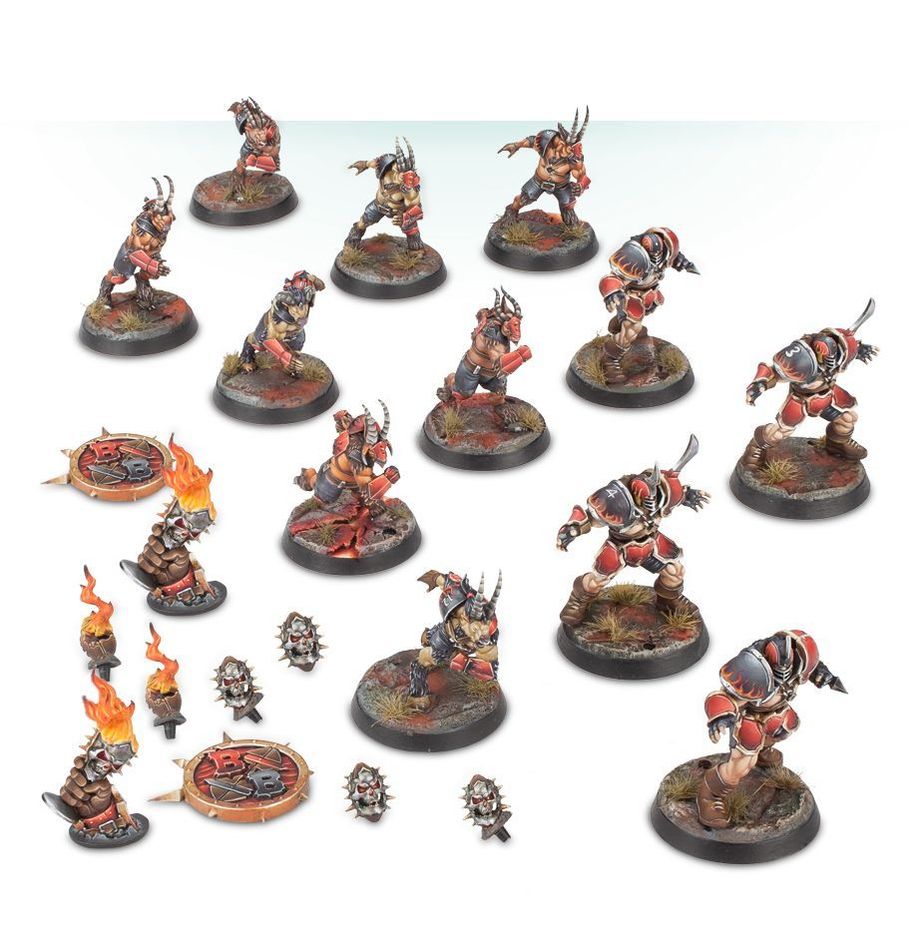
Chaos Dwarf teams are the twisted reflections of their mountain-dwelling cousins—driven not by honour, but by cruelty, industry, and domination. Dwelling in the ash-choked lands of the Dark Lands, they forge weapons, armour, and players alike in smoke-belching factories devoted to Hashut, the Father of Darkness. Their teams feature bull-headed monsters, mutated creations, and enslaved Hobgoblins who serve as cheap labour and even cheaper linemen. While slow and surly, Chaos Dwarves bring resilience and ruthless control to the pitch. Every game they play is a grim march of attrition—a grinding engine of pain and precision, fueled by spite and molten iron.
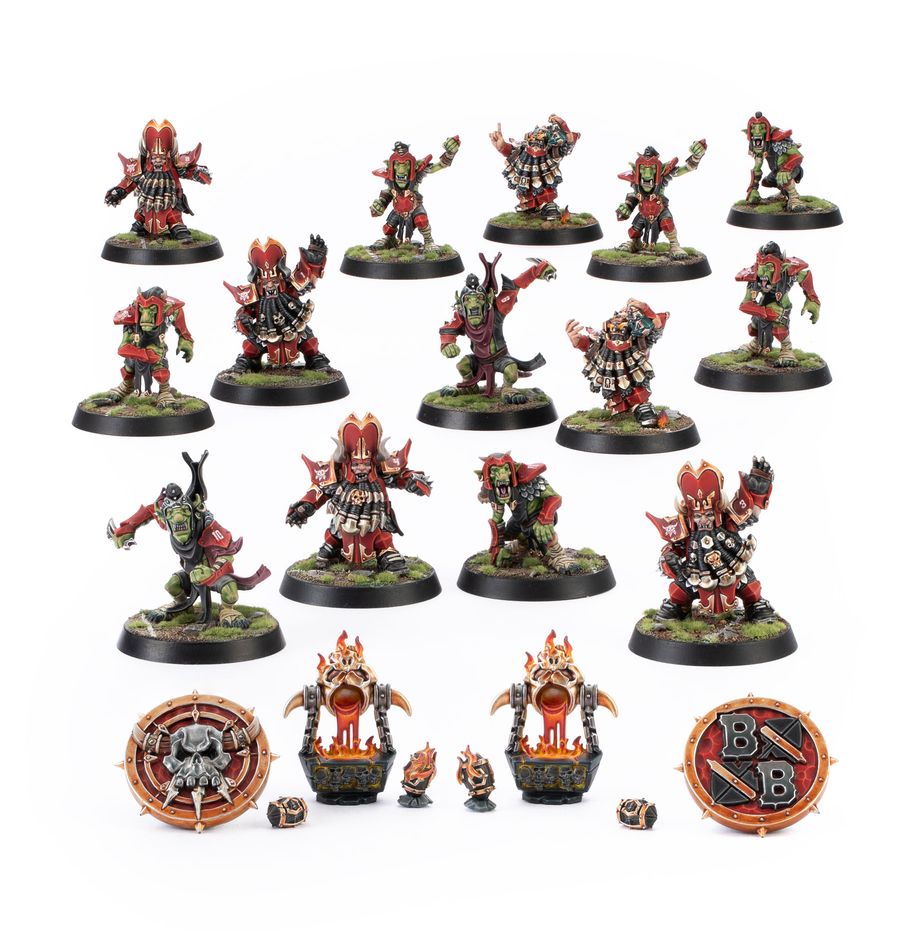
The brother to the Chaos chosen, this mixed chaos team take all your favourite chaos ridden players and mashes them togother for some mutatation related shenanigans.
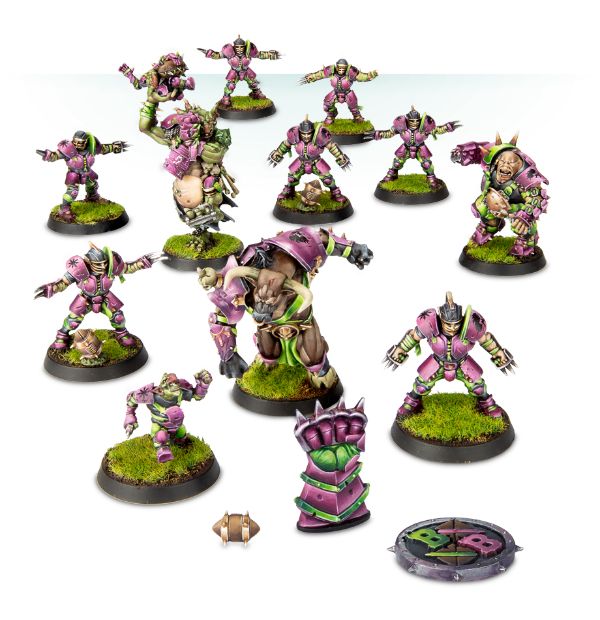
Thousands of years ago, the Dark Elves were little more than a small group within High Elf society who turned their back on traditional Elven ways. They eschewed nobility and grace for power and glory, believing their immortality marked them out as the most powerful of all the world’s races. Their thirst for conquest led to a bitter civil war that rocked the Elven kingdoms. Dark Elf teams exhibit similar strengths and weaknesses to their Elven cousins, but are distinctly more aggressive in their game.
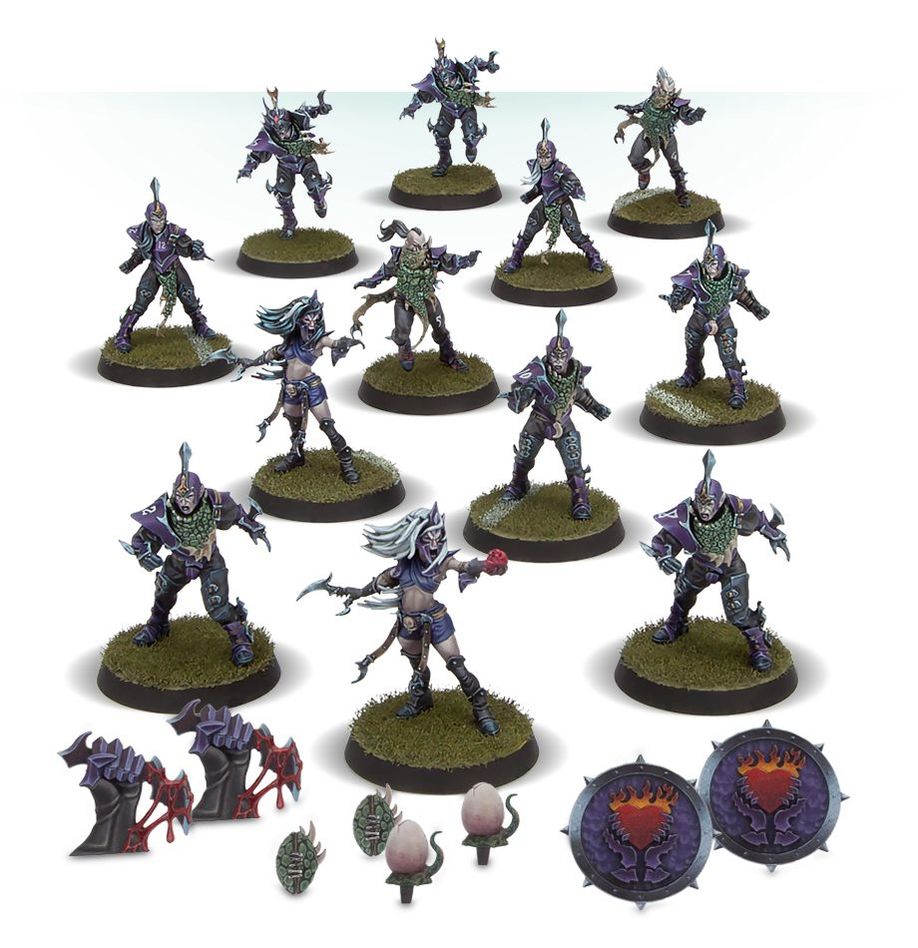
Dwarves (or Dwarfs – you be the judge), one of the original two races to discover and play Nuffles sacred game. There is probably no more maligned team in Blood Bowl, and if you play them, be prepared to accept all the banter around you about playing Bloodbowl with stabilisers on etc. etc. They are also probably the easiest counter to the other ‘best’ starting team, Amazons, as their Linemen come with tackle and block, so they bypass the tricksy ladies dodginess and smash them to the ground, at least in theory.
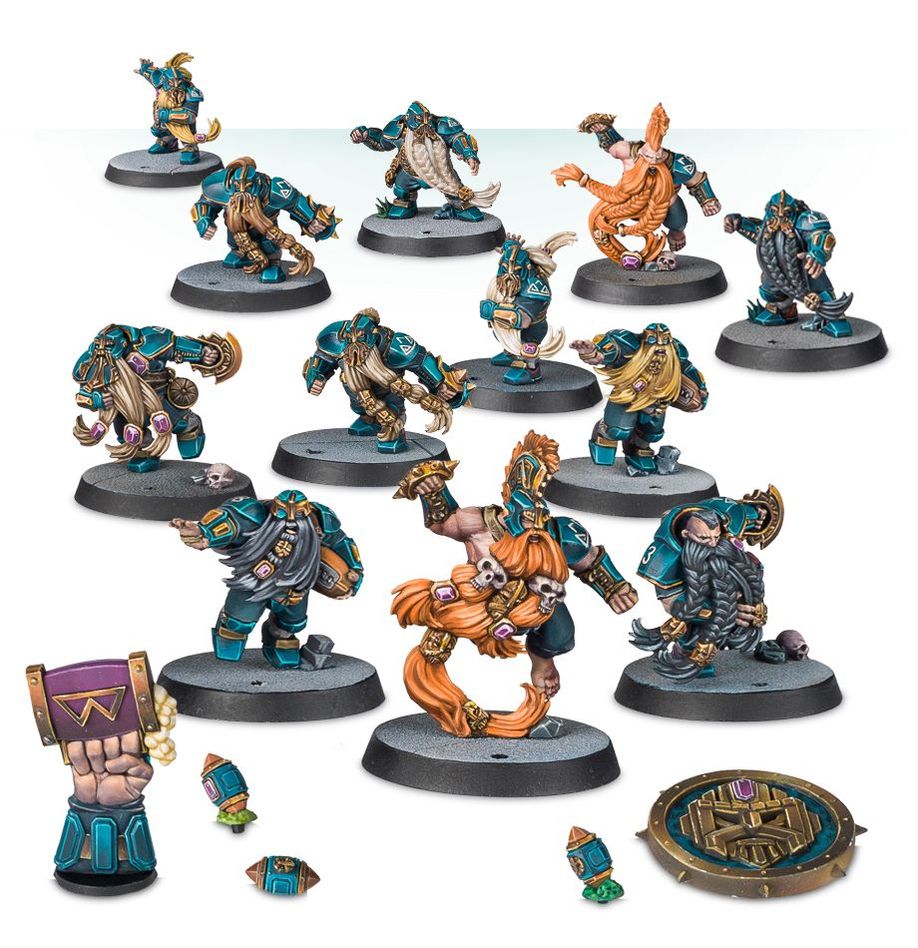
Once proud members of the Elven Kingdoms League, the Elven Union broke away to pursue a more elegant form of Blood Bowl. Eschewing brute force for poise and perfection, they dazzle with balletic passes and graceful maneuvers that blur the line between sport and art. Former High Elf and Wood Elf stars form their ranks, united by disdain for “uncultured” teams that rely on brute strength. Though fragile, they’re fast, accurate, and vain to a fault. Every touchdown is a performance, every match a runway. Win or lose, they always look better doing it than their opponents ever could.
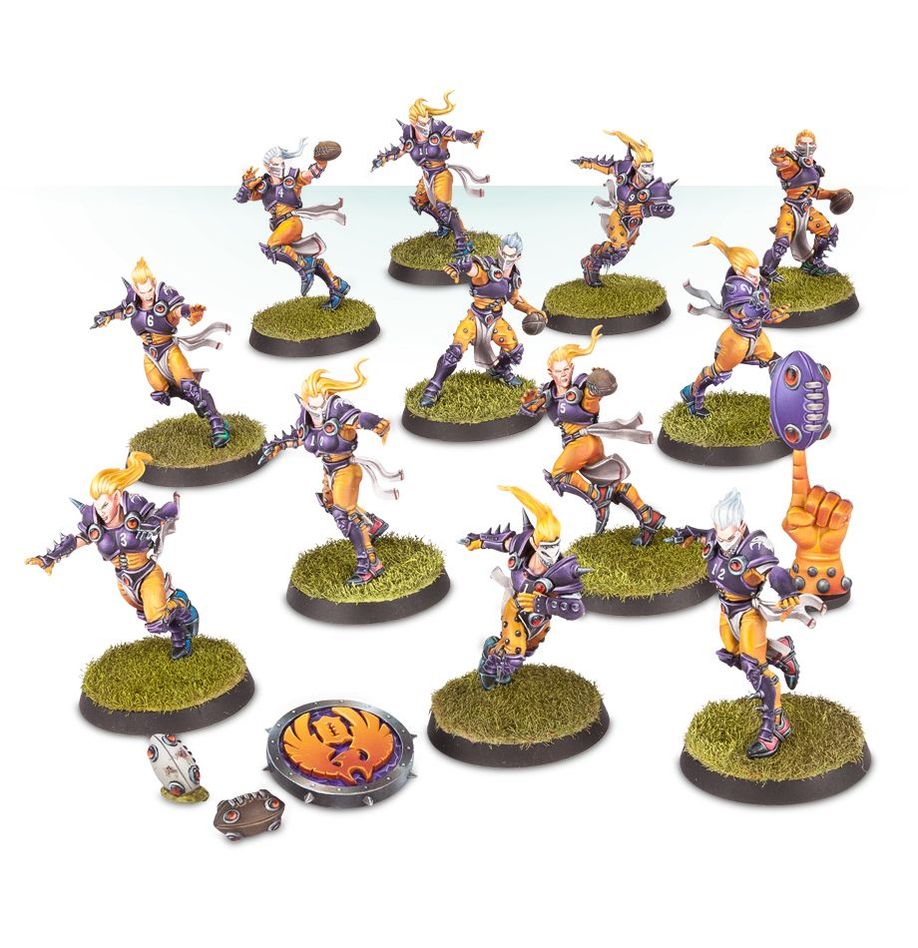
Gnome teams in Blood Bowl are eccentric oddities—sprightly forest folk who defy logic with trickery, gadgets, and unshakable cheer. Hailing from hidden glades and burrows beneath ancient roots, these diminutive players rely more on cunning than clout. They often field mechanical marvels like burrowing drills, jet-propelled contraptions, and the infamous woodland creatures they “train” (or befriend?) for mayhem. Though physically unimposing, Gnomes are masters of illusion and mischief, confusing opponents and turning chaos into opportunity. Teams like the Brambleburrow Bouncers are beloved by fans who prefer pranks over power. Win or lose, they’re the most unpredictable circus the pitch has ever seen.
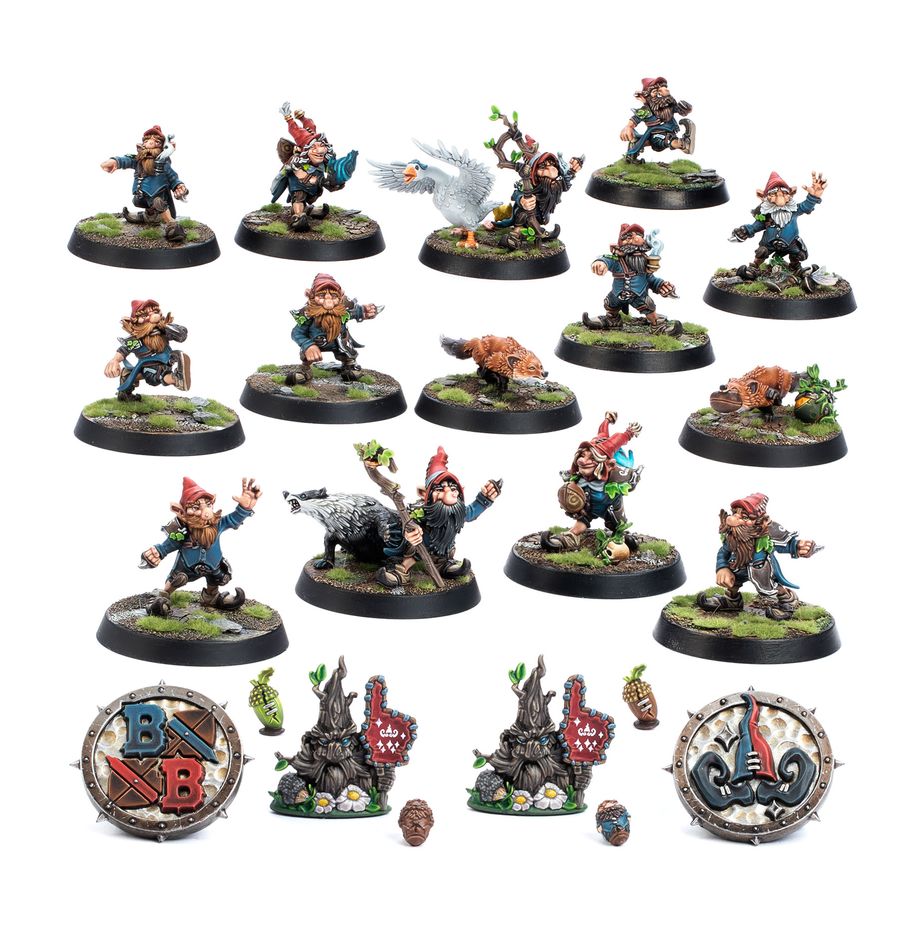
Goblins are cruel, callous, and uncouth, with a juvenile sense of humour and a wicked imagination dedicated to discovering new ways of hurting others without getting hurt themselves. The fact that Goblin teams win even the occasional match can be attributed to one factor: their extensive, flagrant use of “secret” weapons. From chainsaws to pogo sticks to satchels full of explosives, there’s very little a Goblin team won’t use to gain an advantage on the pitch. They’re also known to be incredibly efficient when it comes to fouling- Dirty ‘Arris, who is still looked up to by bribe-happy Gobbos across the land, actually perfected the art of belabouring a downed opponent with a large bag of gold, then releasing it in one smooth motion so it landed neatly at the ref’s feet
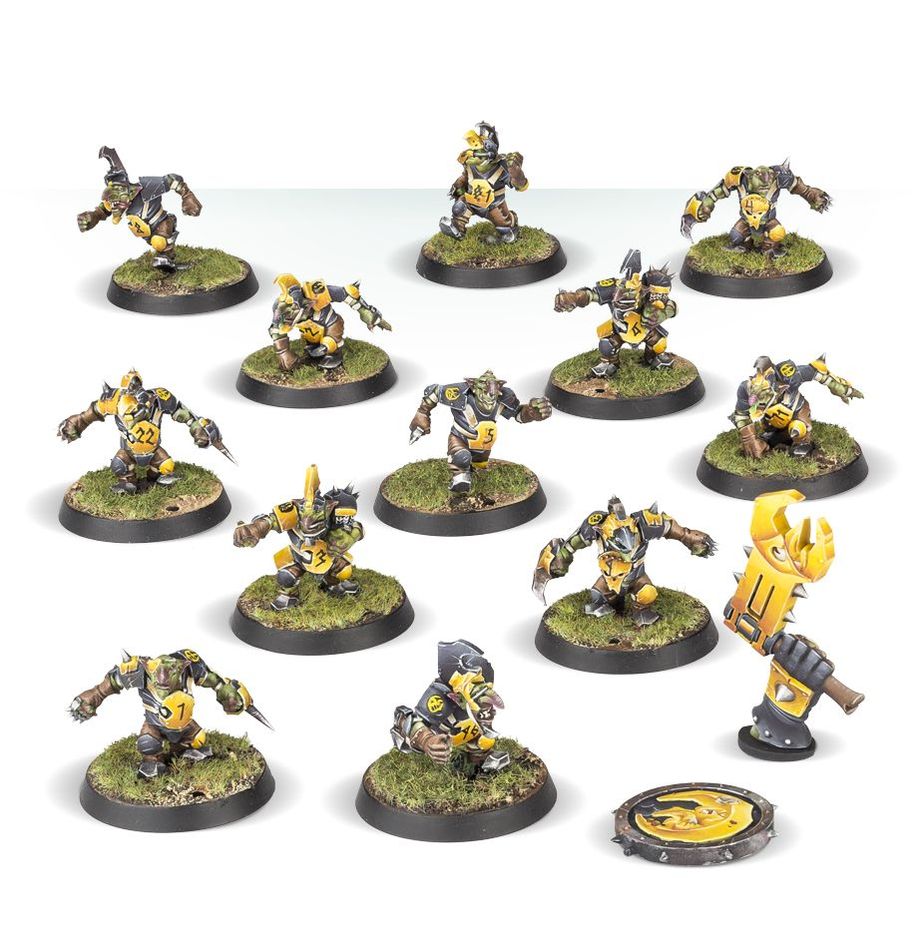
Halflings bring equal parts chaos, charm, and culinary excellence to the pitch. Hailing from the Moot, these pint-sized pranksters are more suited to feasts than fights, yet they field teams with unshakable spirit and endless enthusiasm. Known for their disastrous tackling and snack-fueled strategy sessions, Halflings thrive on mischief and underdog magic. But their secret weapons? The mighty Treemen—towering allies who dish out the violence Halflings can only dream of. Whether flung skyward in a desperate Throw Team-Mate play or scurrying between legs, they play to entertain, embracing every game as a glorious farce with the faint whiff of victory
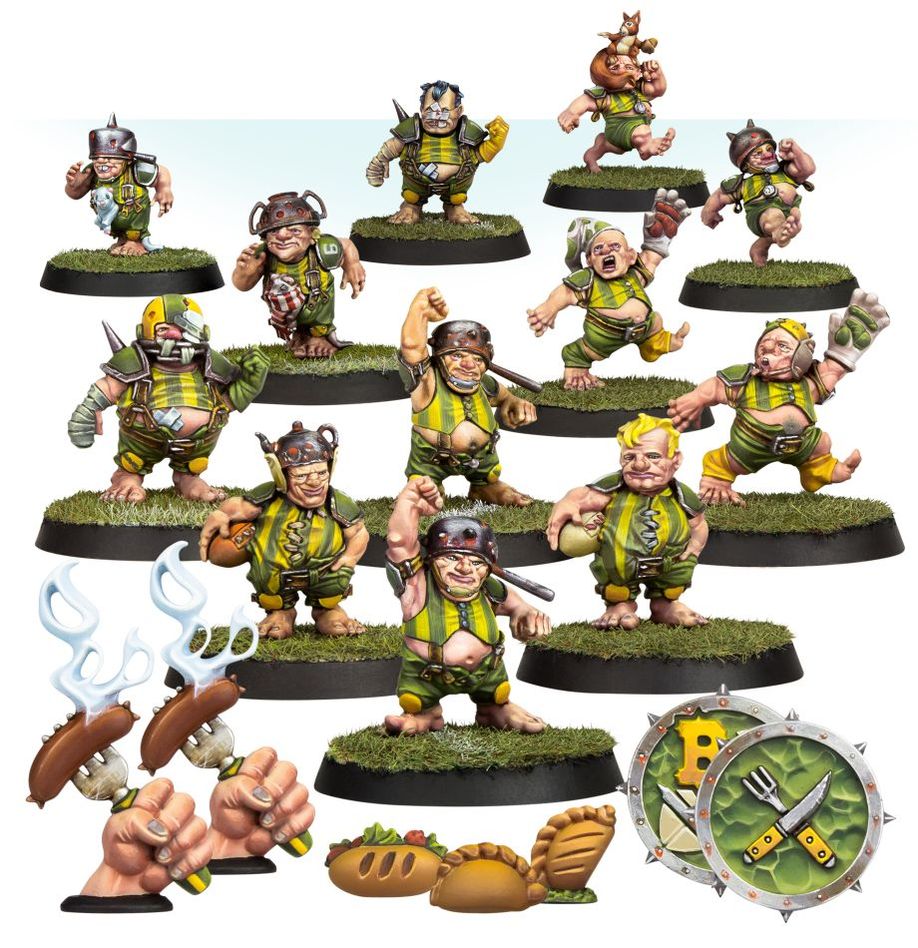
High Elves are very, very good at Bloodbowl. They have AG2+ across the team as you would expect for Elves, but their catchers are able to carry 2 bags of shopping without feeling faint (ie they have st3 not st2) and their thrower is up there with the very best in the game. They can run it, throw it and, as their armour is actually pretty good, you won’t get annihilated in a fight if you get caught out (but do still try to avoid all fights!).
Their drawback? They are very expensive players so you will not get a full roster of positionals and each time one of them gets hurt you will burst into tears while the rest of the league dances a little jig.
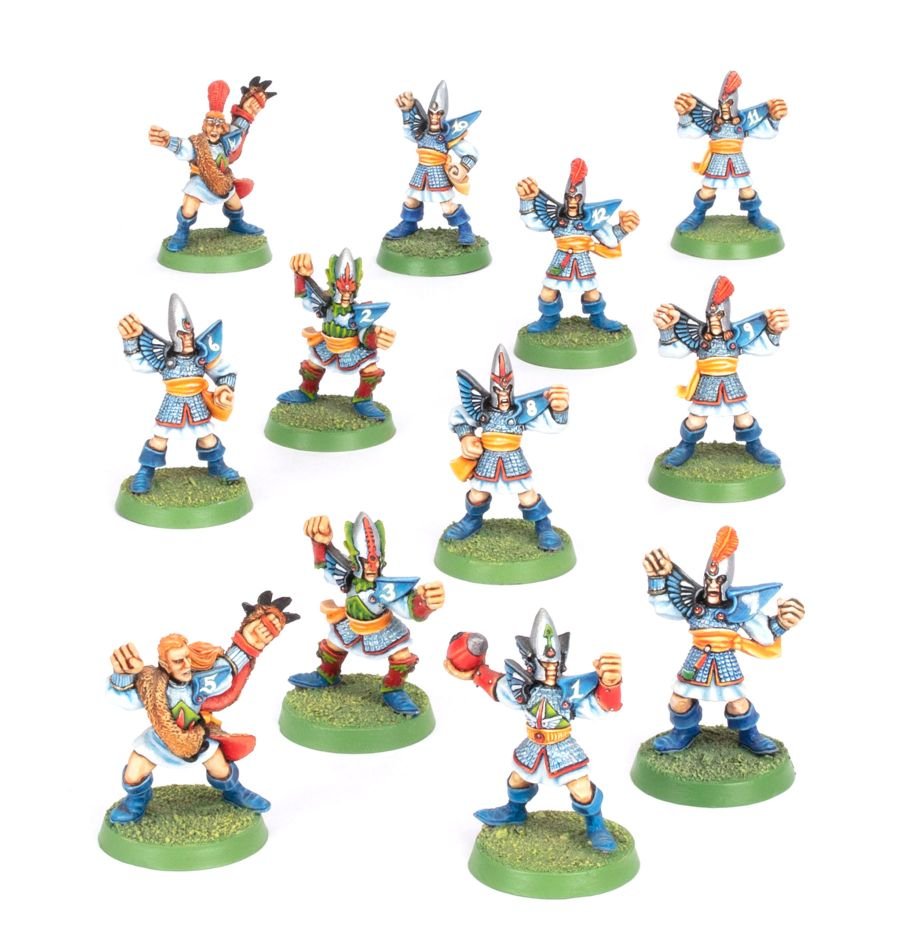
Human teams are the beating heart of Blood Bowl—versatile, adaptable, and fiercely competitive. Hailing from bustling cities and war-hardened provinces of the Empire, these teams represent a melting pot of grit, ambition, and raw talent. Unlike the specialized rosters of other races, Human teams balance speed, strength, and skill, drawing recruits from mercenaries, ex-soldiers, street brawlers, and local legends. Their squads are known for tactical flexibility, making them the proving ground for up-and-coming stars and coaching greatness alike. From the legendary Reikland Reavers to local league hopefuls, Humanity’s pride lies not in perfection, but in perseverance and potential.
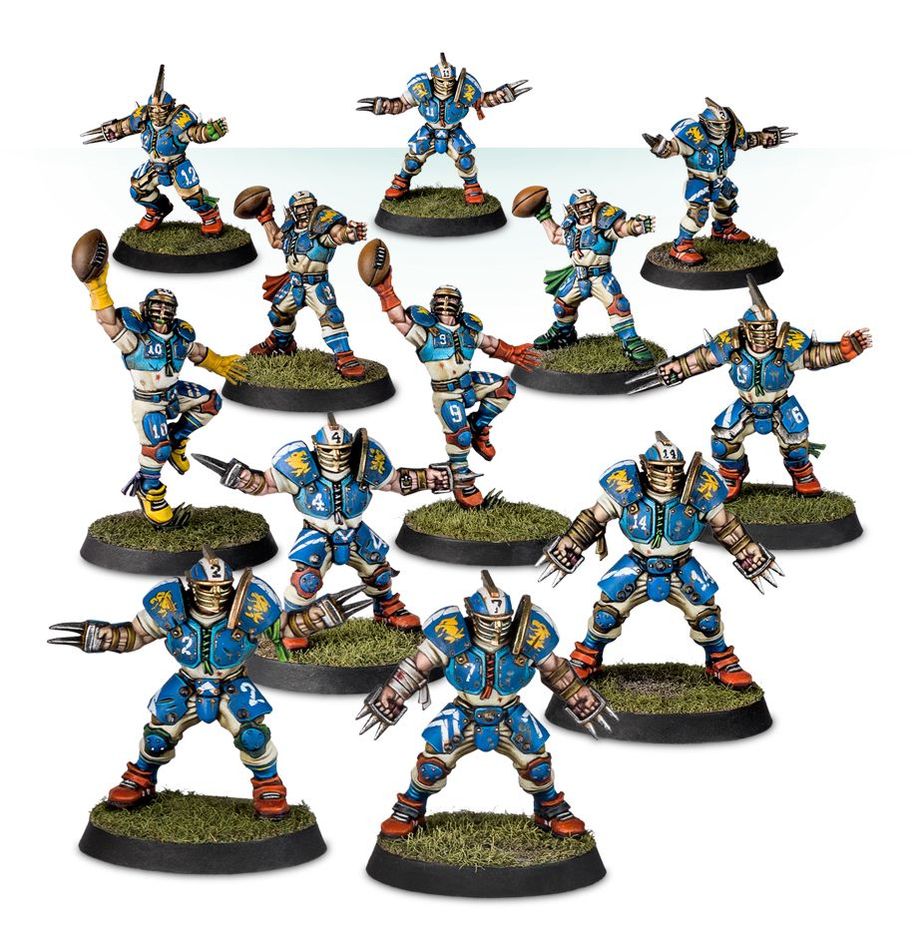
Imperial Nobility teams bring haughty arrogance and heavy coin purses to the pitch, representing the upper crust of the Empire’s elite. These gilded warriors, often former duelists, fencers, and ex-military officers, play not out of necessity, but as a spectacle of privilege and refinement. Backed by powerful sponsors and clad in immaculate livery, they rely on their bodyguards—hulking Blitzers and Ogre enforcers—to keep the rabble at bay. Their throwers and nobles favour precision and discipline, a stark contrast to the chaos around them. With snide sneers and well-paid referees, they’re here to prove that bloodshed, too, can be a noble pursuit.
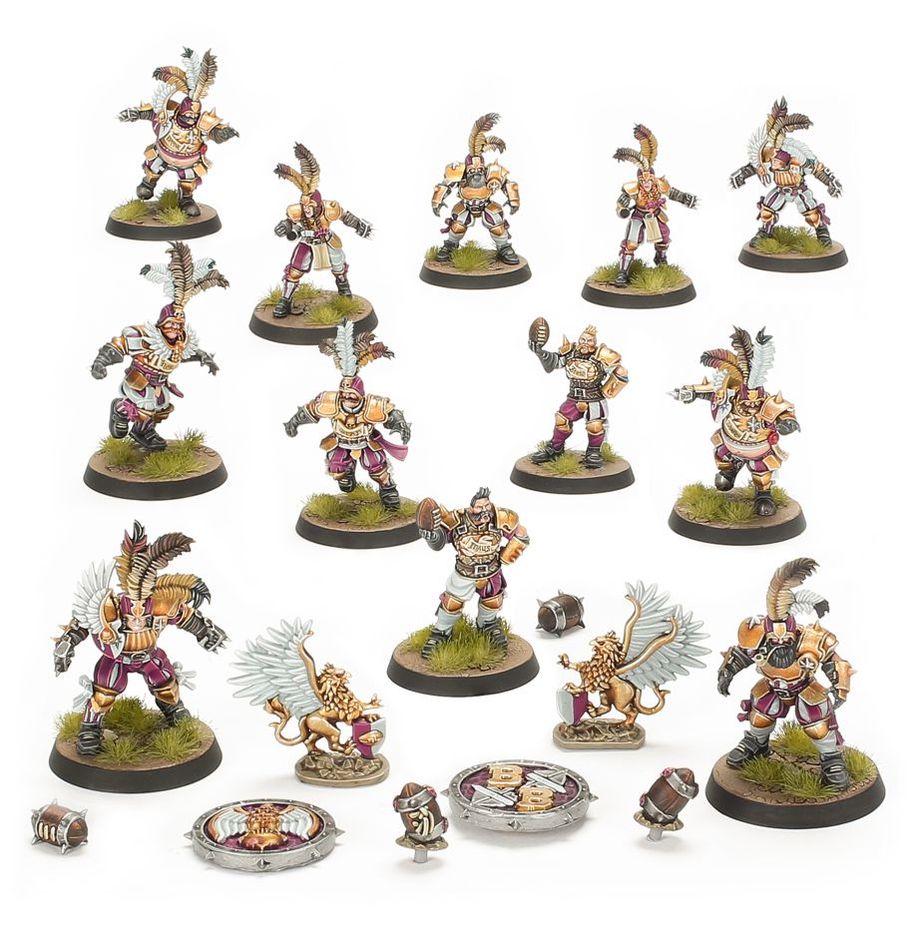
Born of rage and soaked in blood, Khorne teams charge onto the Blood Bowl pitch as brutal emissaries of the Blood God himself. These squads aren’t here to win hearts or trophies—they’re here to spill blood and earn favour through carnage. Formed in the blasted hellscapes of the Chaos Wastes, Khorne teams draw from frenzied marauders, snarling Bloodseekers, and demonic forces thirsting for violence. Revering skulls more than touchdowns, they see the game as a sacred rite of destruction. Their fans chant for slaughter, not strategy—and when they play, every whistle sounds like a war cry.
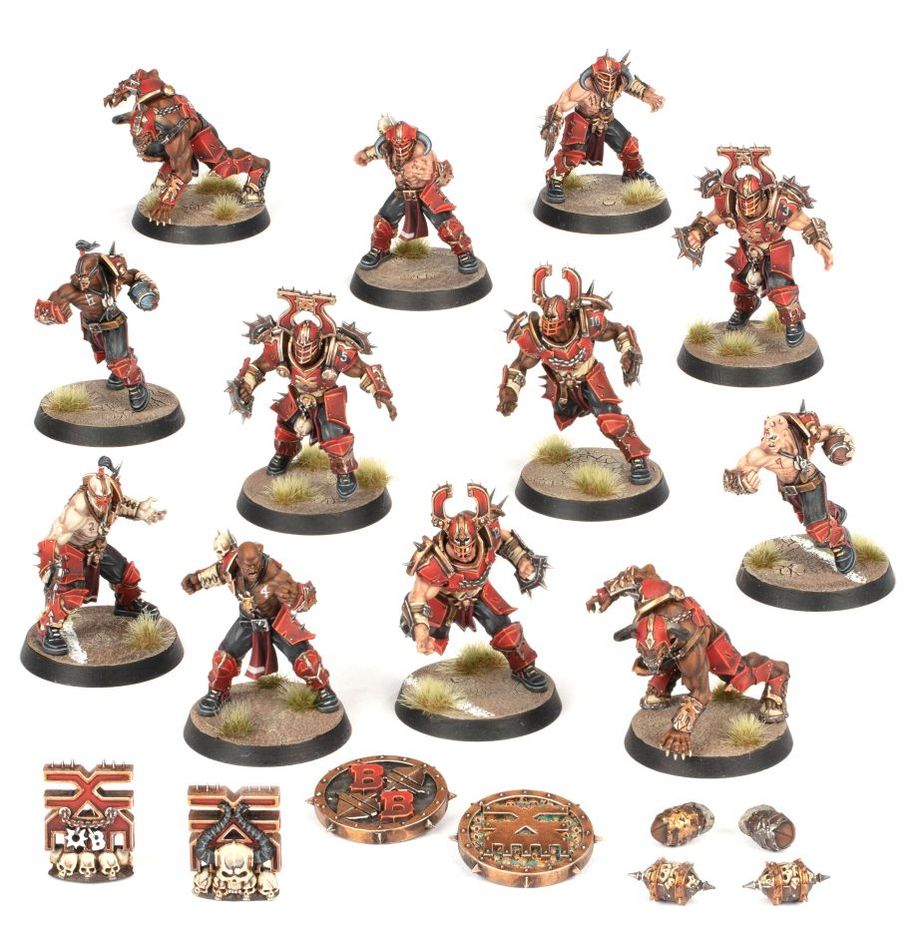
According to the annals—if Blood Bowl historians are to be taken at face value—Lizardmen have been competing on the pitch for more than 8,000 years. That timeline might raise a few scales of suspicion, but press them on it and you’ll get a smug nod, a glint behind the spectacles, and a cryptic remark about the Lizardmen’s uncanny foresight. However they got involved, one thing’s certain: their presence in the sport is anything but subtle. Dinosaurs in shoulder pads—honestly, that’s all some coaches need to hear before jumping on the Lizardmen bandwagon.
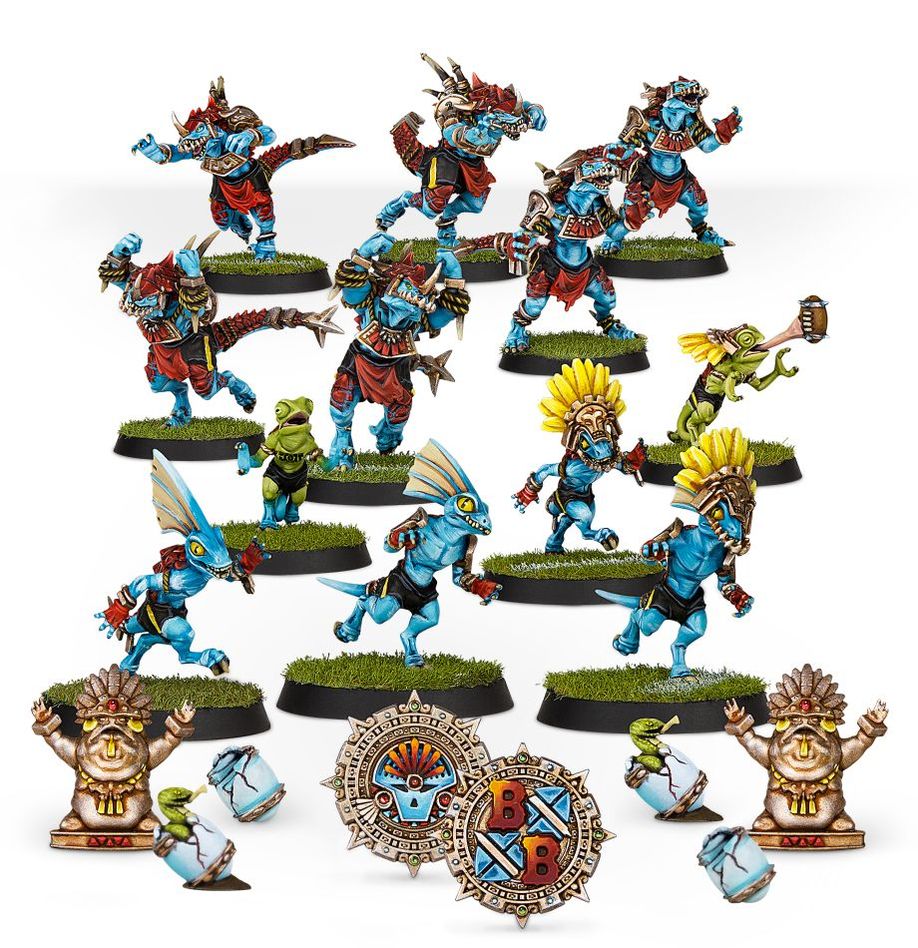
Necromantic teams have some of the most varied positionals of any team. Slow but durable Zombies flesh out your lineup, but the real fun comes in how you build your specialised players, and a savvy Necromancer can tailor the team to a variety of play styles. Ghouls and Werewolves bring speed, Wraiths are slippery, and Flesh Golems are strong and tough. And as most of the players have a 50/50 chance to heal from bad injuries (a skill that seems to work about 1 time in 10), they’ll sometimes be back for more.
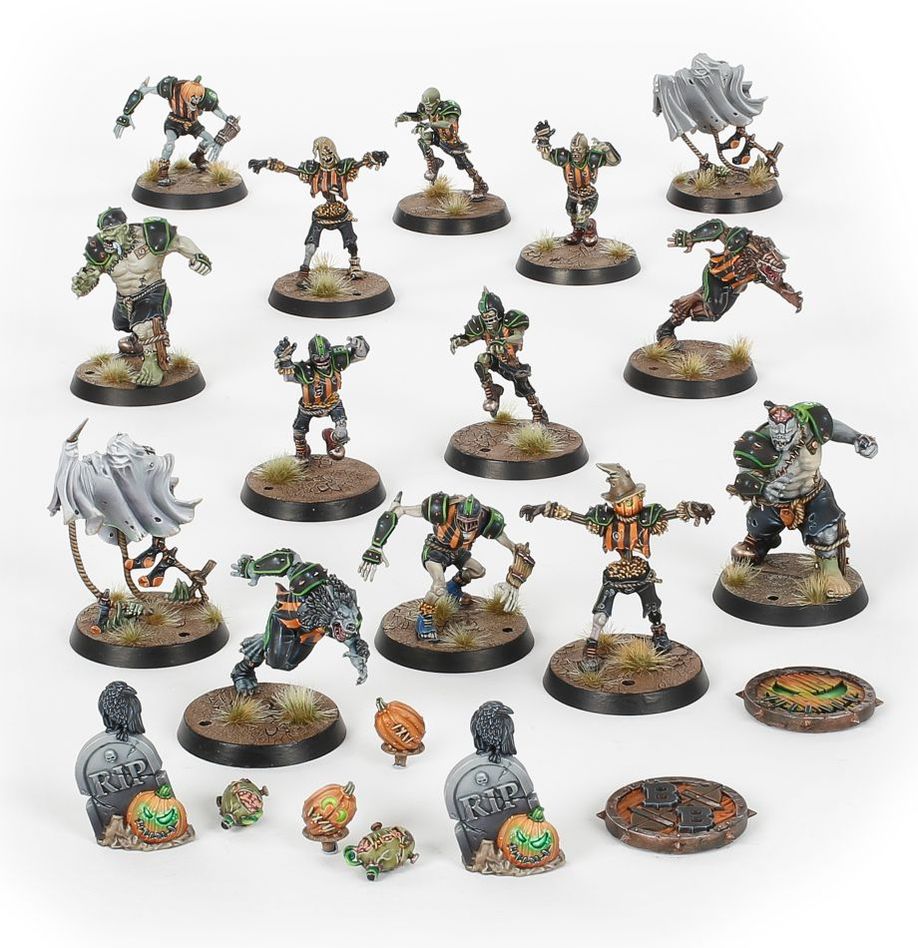
Hailing from the frigid fjords of Norsca, Norse Blood Bowl teams are wild, hard-drinking brawlers who view the game as just another excuse for glorious combat. Fueled by mead, madness, and sheer machismo, they charge into matches with reckless abandon, fists flying and beards bristling. Their lineups mix berserkers, ulfenwerers, and hardy linemen with scant regard for self-preservation. While tactics are optional and passes rare, few can match their hunger for carnage. Every touchdown is a war cry, every block a saga. Win or lose, the Norse play for glory, honour, and the next tankard of ale.
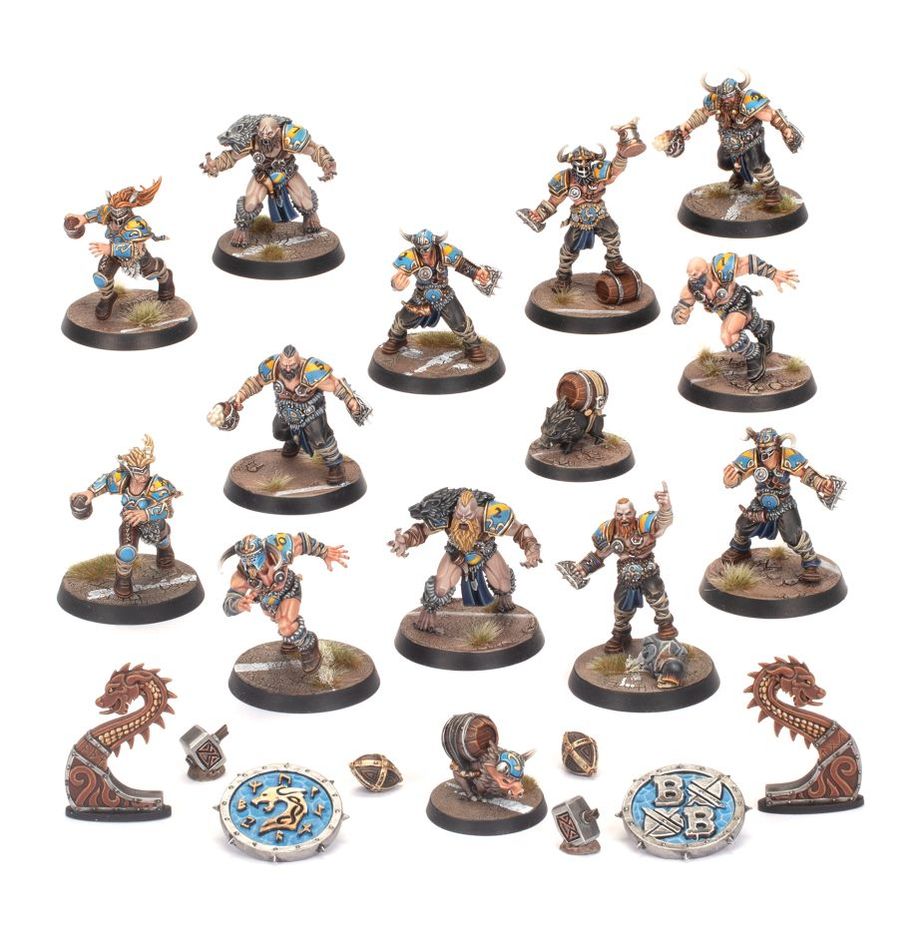
From the festering pits of decay and despair crawl the blessed followers of Nurgle, the Plague Lord. Nurgle teams embody rot, resilience, and relentless contagion. Their players—bloated Bloaters, oozing Rotspawn, and pestilent Pestigors—shuffle onto the pitch trailing clouds of disease, spreading Papa Nurgle’s “gifts” with every blocked tooth and mangled tackle. They’re not out to score—they’re here to share the love… one pus-filled punch at a time. Cheered on by groaning Nurglings and diseased fans, they represent rot-as-resistance, transforming suffering into strength. To face them is to face entropy itself—inevitable, sticky, and disturbingly cheerful about it.
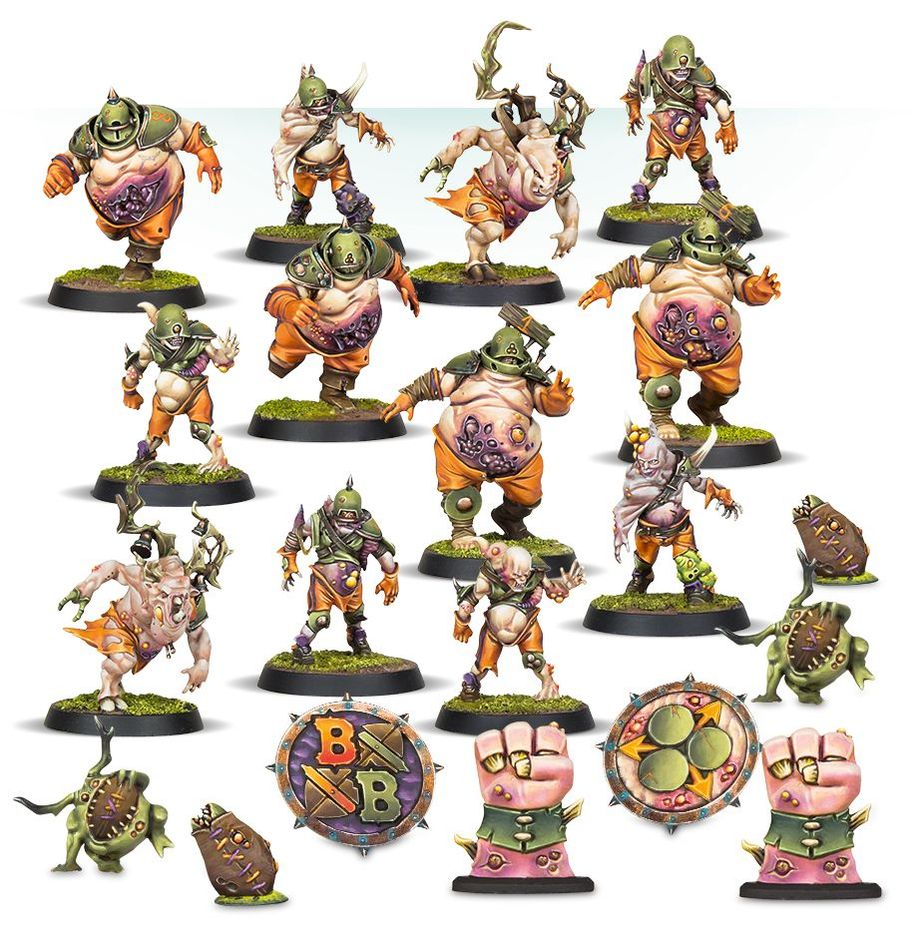
From the snow-capped peaks of the Mountains of Mourn to the muddy alleys of backwater leagues, Ogres play Blood Bowl for one simple reason: they like to hit things. Glorified mercenaries with a love for food, fists, and fame, these massive bruisers make terrifying team captains. Their teams are a rowdy mix of hulking Ogres and nimble-yet-doomed Snotlings—tiny teammates whose main function seems to be getting squashed, flung, or eaten. Driven by hunger, greed, and the occasional urge to punt something squishy, Ogre teams aren’t elegant or strategic. But when they roll onto the pitch, the audience can’t look away.
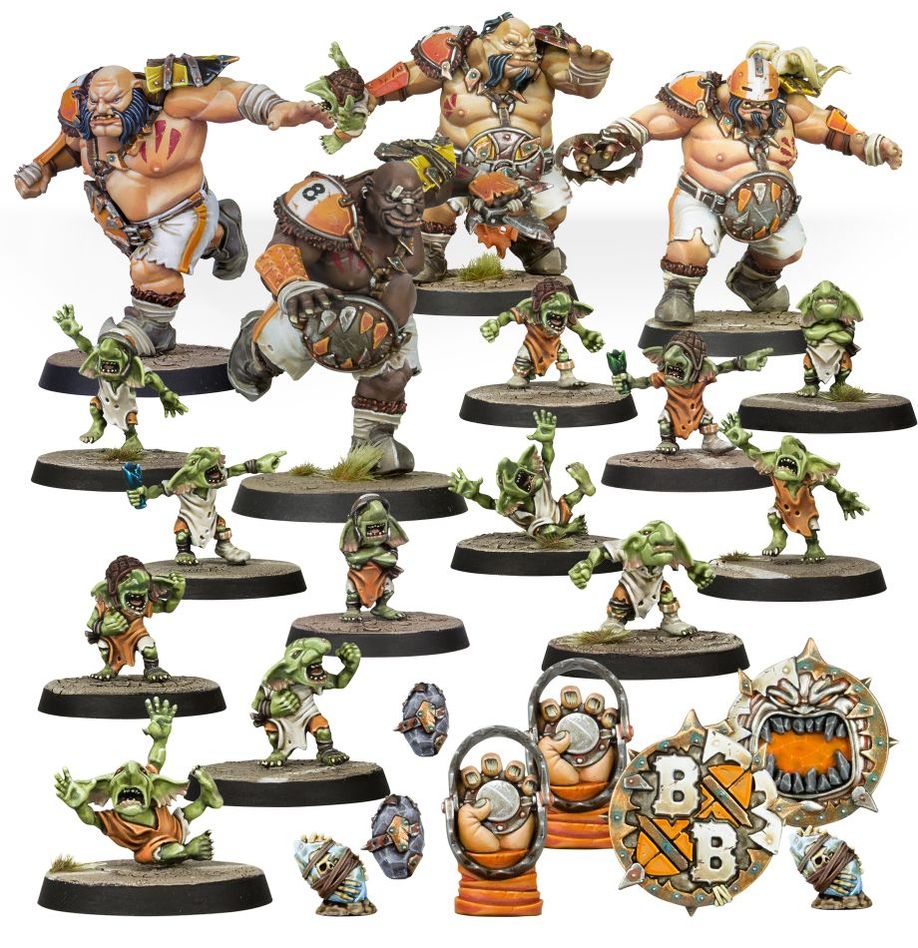
The Old World Alliance teams are a diplomatic nightmare stitched together with duct tape, grudges, and wishful thinking. Formed in the spirit of pan-racial cooperation (and mutual distrust), these squads combine Humans, Dwarfs, Halflings, and the odd Ogre—all united under one confused banner. Originating from politically motivated leagues and awkward guild contracts, the Alliance rarely agrees on anything… except playing Blood Bowl. Dwarf stubbornness clashes with Human ambition, while Halflings sneak snacks mid-drive. Yet when it clicks, their diversity becomes strength. Teams like the Middenheim Maulers prove that with enough headbutts and halftime negotiations, even chaos can find camaraderie
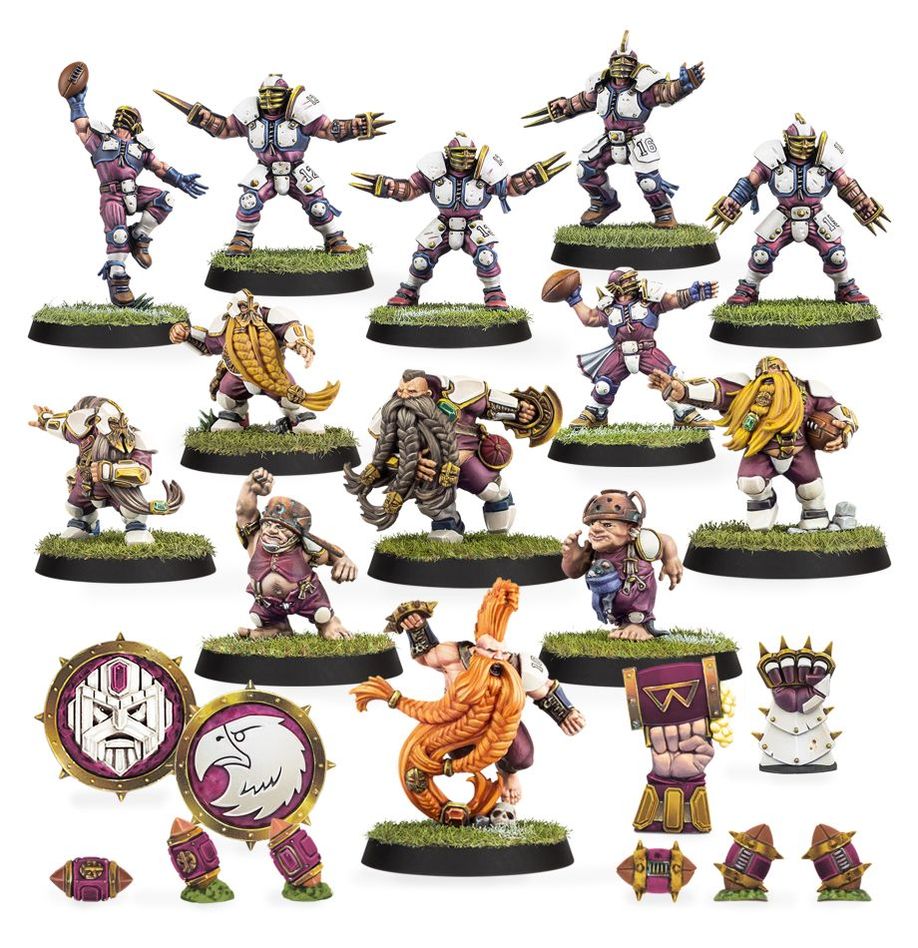
Orcs have been part of Blood Bowl since its earliest days—after all, it was an Orc who first unearthed the shrine containing the legendary Tome of Nuffle. True to form, Orc teams favour brute force over finesse, aiming to flatten opponents and open up lanes for their Blitzers to charge through. If they have a flaw, it’s that they’re either brawling with each other or relentlessly clobbering the opposition. Valuing muscle over brains, Orcs typically stack their scrimmage with hulking Big ’Uns and even Trolls. They also share strong ties with other Greenskins, so spotting Goblins in their ranks is hardly unusual.
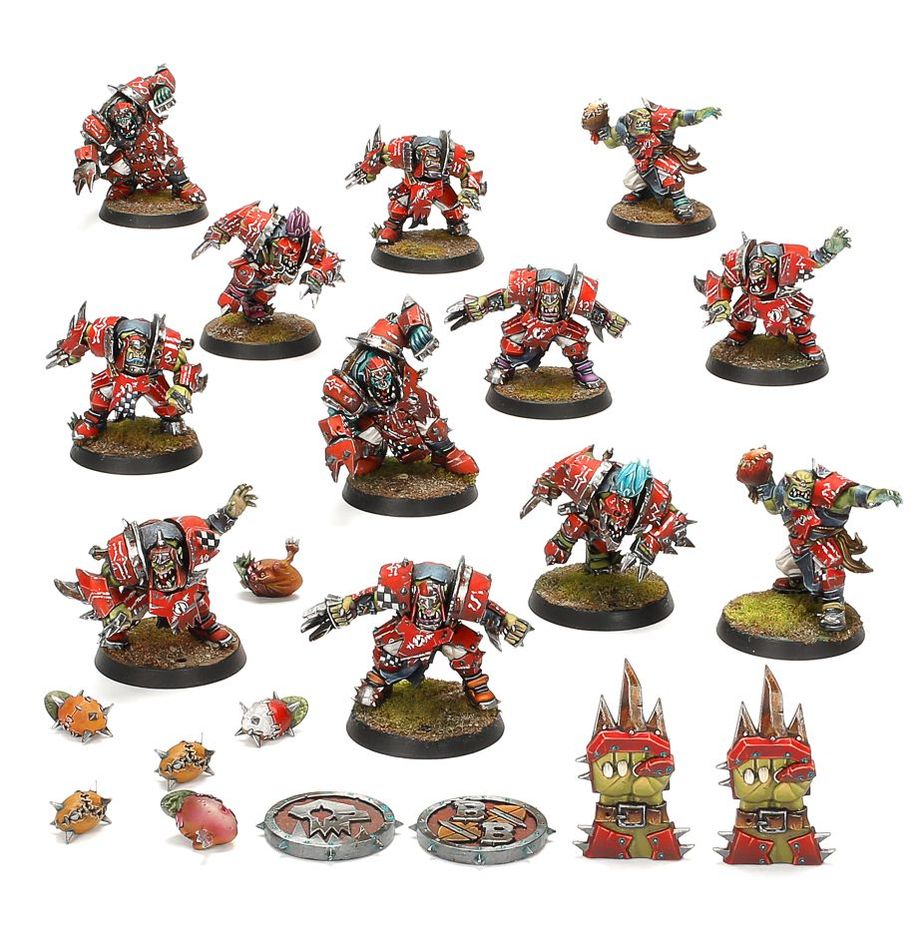
Shambling Undead teams are drawn from a mix of vicious undead creatures and former Blood Bowl players that died on the pitch and – through the art of necromancy – have been given the chance of a second career!
This team has lots of choices in start up and player/team development so you can really tailor it to suit your own coaching style.
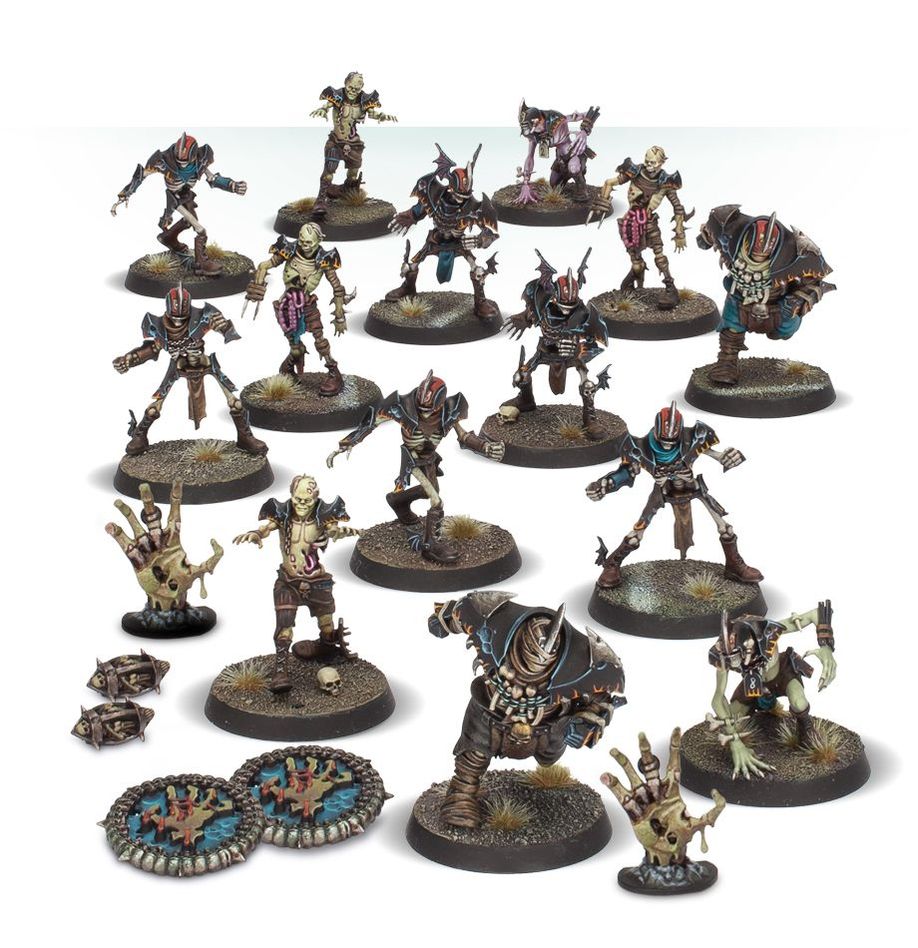
Skaven, the rat-men of the Old World living in tunnels deep beneath cities all across the continent. Skaven take to Blood Bowl very well, their natural speed finding a perfect home on the pitch and allowing them to compete with the very best Blood Bowl has to offer.
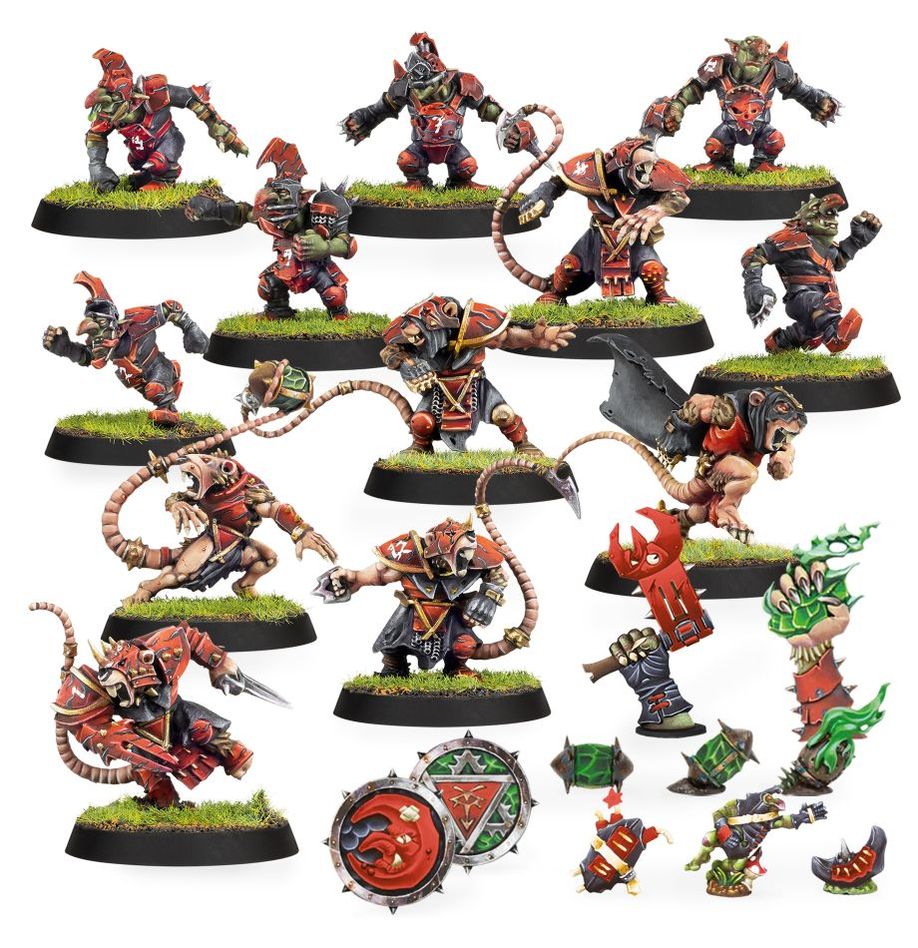
Snotling teams are the chaotic dregs of the Blood Bowl world—tiny, filthy, and barely sentient, but somehow sanctioned to compete. Spawned from squig dung heaps, mushroom groves, and Goblin-infested hovels, Snotlings play for the joy of mayhem and the occasional stale pie. They swarm the pitch in numbers so ridiculous it becomes more infestation than formation. Coaches are usually mad, cruel, or both, relying on sheer body count and sheer audacity. With pump wagons, fungus-fueled lunatics, and boundless enthusiasm, Snotlings are the league’s underdogs… if “dogs” implies they chew wires, eat paint, and explode when overly excited.
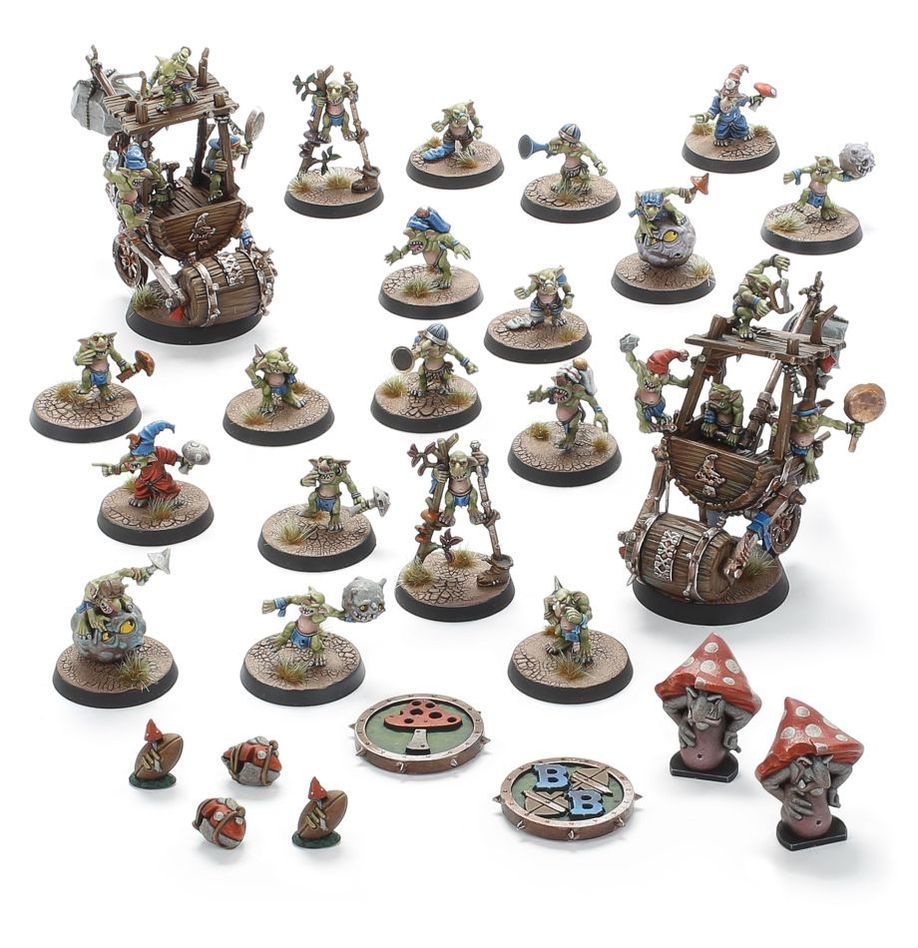
Emerging from the sun-scorched sands of Nehekhara, the Tomb Kings are ancient monarchs and warriors resurrected to reclaim glory—not through conquest, but on the Blood Bowl pitch. Once rulers of a mighty empire, they now travel in gilded barges adorned with relics of their past, bringing a regal, if slightly dusty, presence to the game. Flavour-wise, they’re a fascinating mix of faded grandeur and undead stubbornness. Their helmets are carved in the likeness of ancient gods, anointed with sacred oils, and their every move seems to echo the rituals of a bygone age. They may be slow, but underestimate them and you’ll find yourself buried—literally and figuratively—beneath the weight of history.

Underworld Denizens teams recruit from the dank caves and foul sewers that lurk beneath the surface, bringing Goblins, Snotlings and Skaven together in a cocktail of fur, fungus, and foul play. They have 8 player profiles to choose from, but the positionals are 0-1, so you don’t get many of them and you’ll need to look after them if you want to stay in the game!

In the twisted world of Blood Bowl, Vampire teams bring a mix of aristocratic elegance and chilling brutality. Hailing from ancient, crumbling castles, these undead lords descend upon the pitch with thralls in tow—disposable minions who serve both as teammates and mid-match snacks. Vampires possess immense strength, agility, and hypnotic powers, but their Bloodlust trait means games often devolve into chaotic feasts. Teams like the Sylvania Soul Stealers and the Lahmian Shadows are infamous for their cruel tactics and eerie glamour. Playing them is a gamble between brilliance and catastrophe… but watching them? Absolutely fang-tastic.
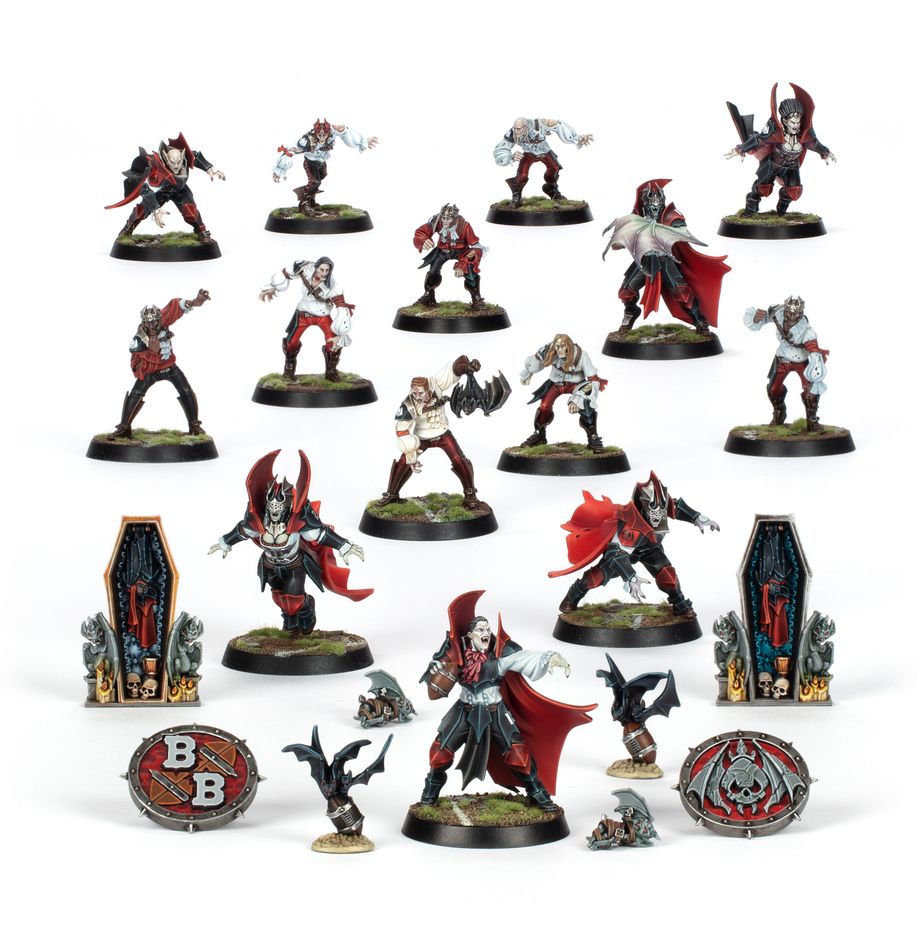
Wood Elf teams in Blood Bowl hail from the ancient forest realms, where speed, grace, and precision are woven into their culture as tightly as their ivy-clad uniforms. Unlike their brutish kin, these elves treat Blood Bowl as an art form—a deadly ballet danced upon the turf. They emerge from woodland enclaves like Athel Loren, representing factions of Waywatchers, Wardancers, and Forest Spirits who see the pitch as a proving ground for agility and instinct. They shun brute force for elegant destruction, striking swiftly and vanishing like mist. Though aloof and enigmatic, they play with an untamed beauty that captivates… then kills.
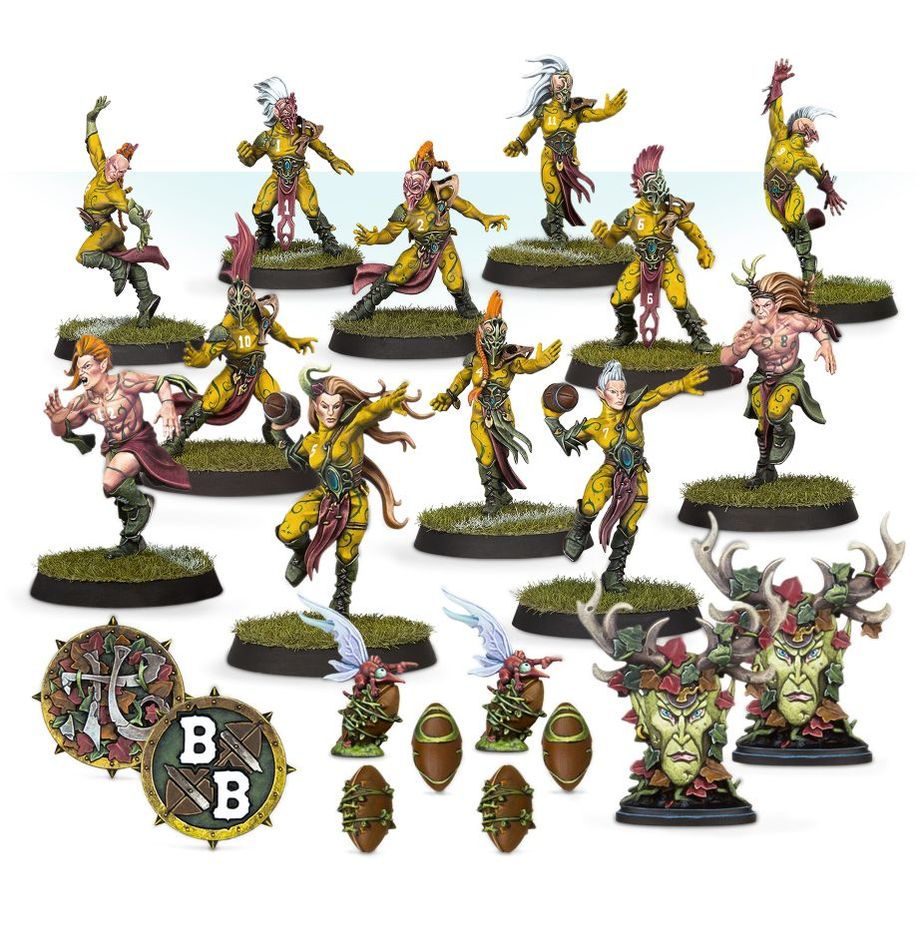
Ways to play
Whilst this guide is primarly focused on ‘tabletop’ Blood Bowl, there are a few very popular alternatives. which can be great tools to help new coaches learn the game mechanics and team playstyles.
Tabletop Blood Bowl
Blood Bowls ‘bread and butter’ format and the primary focus of this guide. Good old models, cardboard (or neoprene) pitches and blessed cubes of Nuffle. The best way to experience Blood Bowl.
Blood Bowl III (or, Warhammer Blood Bowl)
BB3 is the flashy digital video game available on all the usual formats. The game features both single-player and multiplayer modes, and it runs on the updated Second Season ruleset. It also introduced a seasonal battle pass system called the “Blood Pass,” which unlocks cosmetics and new factions.
FUMBBL
The largest online Blood Bowl league in the world. Free to join and lets you create teams from official and unofficial rosters.
It’s more old-school compared to BB3, but it’s beloved for its community spirit, faithful adherence to the rules.
Variants
Alongside standard ’11s’ Blood Bowl, there are various other ways to experience Nuffles favour…
Dungeon bowl
Dungeon Bowl is a chaotic, underground twist on the classic fantasy sports game Blood Bowl. Instead of playing on a traditional pitch, teams clash in a sprawling dungeon filled with traps, teleporters, and treasure chests—only one of which contains the actual ball.
sevens
Blood Bowl Sevens is a fast-paced, stripped-down version of the classic Blood Bowl game—think of it as fantasy football in a hurry. Only 7 players on the pitch per side and rosters are capped at 11 total players. Games are played in two 6-turn halves rather than the usual 8, making matches quicker—often under an hour.
gutter bowl
Imagine fantasy football played in the alleys and sewers of the Old World, with no referees, barely any rules, and a whole lot of chaos.
Games are played on a double-sided pitch: one side is a cobblestone street cluttered with market stalls, and the other is a sewer filled with sludge pits and hazards. Players must dodge obstacles, shove opponents into barricades, and occasionally get flung into sewer grates—sometimes hilariously, sometimes horrifically.
Once a new coach is familiar with the basics of Blood Bowl, these variants are great fun to explore.
TourPlay *WIP*
Tourplay.net is the preeminent platform leagues and tournaments use to facilitate their competitions so we’ve a little section in this guide to highlight some of the basics we feel are useful for new coaches to understand.
joining a competition
Lorem ipsum dolor sit amet, consectetur adipiscing elit, sed do eiusmod tempor incididunt ut labore.
setting up your team
Lorem ipsum dolor sit amet, consectetur adipiscing elit, sed do eiusmod tempor incididunt ut labore.
playing a match
Lorem ipsum dolor sit amet, consectetur adipiscing elit, sed do eiusmod tempor incididunt ut labore.
need support?
Lorem ipsum dolor sit amet, consectetur adipiscing elit, sed do eiusmod tempor incididunt ut labore.
Resources *WIP*
Lorem ipsum dolor sit amet, at mei dolore tritani.
Lorem ipsum dolor sit amet, at mei dolore tritani.
Lorem ipsum dolor sit amet, at mei dolore tritani.
Lorem ipsum dolor sit amet, at mei dolore tritani.
Lorem ipsum dolor sit amet, at mei dolore tritani.
Lorem ipsum dolor sit amet, at mei dolore tritani.
PLAY THE GAME!
New coaches should now feel armed with plenty of information to help take their first steps into the game. There’s loads of reading and video material out there to help, but remember, the best way to learn and have fun is to play Blood Bowl!
